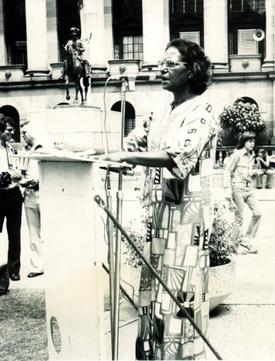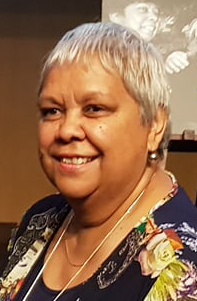
Brisbane is the capital and most populous city of Queensland, and the third-most populous city in Australia and Oceania with a population of approximately 2.6 million. Brisbane lies at the centre of South East Queensland, which includes several other regional centres and cities. The central business district is situated within a peninsula of the Brisbane River about 15 km (9 mi) from its mouth at Moreton Bay. Brisbane is located in the hilly floodplain of the Brisbane River Valley between Moreton Bay and the Taylor and D'Aguilar mountain ranges. It sprawls across several local government areas, most centrally the City of Brisbane. The demonym of Brisbane is Brisbanite.

Stradbroke Island, also known as Minjerribah, was a large sand island that formed much of the eastern side of Moreton Bay near Brisbane, Queensland until the late 19th century. Today the island is split into two islands: North Stradbroke Island and South Stradbroke Island, separated by the Jumpinpin Channel.

Oodgeroo Noonuccal ( UUD-gə-roo NOO-nə-kəl; born Kathleen Jean Mary Ruska, later Kath Walker was an Aboriginal Australian political activist, artist and educator, who campaigned for Aboriginal rights. Noonuccal was best known for her poetry, and was the first Aboriginal Australian to publish a book of verse.

Melanesian Meriam people are an Indigenous Australian group of Torres Strait Islander people who are united by a common language, strong ties of kinship and live as skilled hunter–fisher–gatherers in family groups or clans on a number of inner eastern Torres Strait Islands including Mer or Murray Island, Ugar or Stephen Island and Erub or Darnley Island. The Meriam people are perhaps best known for their involvement in the High Court of Australia's Mabo decision which fundamentally changed land law in Australia - recognising native title.

Peel Island is a small heritage-listed island located in Moreton Bay, east of Brisbane, in South East Queensland, Australia. The island is a locality within the local government area of Redland City and a national park. In the 2016 census, Peel Island had a population of 0 people.

Dunwich is a town and locality on the western side of North Stradbroke Island in Queensland, Australia. Dunwich is part of the Redland City local government area, administered from the bayside town of Cleveland on the Queensland mainland. In the 2016 census, Dunwich had a population of 864 people.

Lourdes Hill College is a Good Samaritan Education secondary day school for girls, located in the inner-eastern Brisbane suburb of Hawthorne, Queensland, Australia. The college also operated as a boarding school until its boarding facilities were closed in 2011.

Hawthorne is a suburb of the City of Brisbane, Queensland, Australia. In the 2016 census, Hawthorne had a population of 4,989 people.
Lilla Watson is a Murri visual artist, activist and academic working in the field of Women's issues and Aboriginal epistemology.

Jacqueline Gail "Jackie" Huggins is an Aboriginal Australian author, historian, academic and advocate for the rights of Indigenous Australians. She is a Bidjara/Pitjara, Birri Gubba and Juru woman from Queensland.

The Quandamooka people are Aboriginal Australians who live around Moreton Bay in Southeastern Queensland. They are composed of three distinct tribes, the Nunukul, the Goenpul and the Ngugi, and they live primarily on Moreton and North Stradbroke Islands, that form the eastern side of the bay. Many of them were pushed out of their lands when the English colonial government established a penal colony near there in 1824. Each group has its own language. A number of local food sources are utilised by the tribes.
The Goenpul, also written Koenpal, are an Aboriginal Australian people, one of three Quandamooka peoples, who traditionally lived on the southern part of Stradbroke Island in southern Queensland. Today their preferred term for their group is Dandrubin Gorenpul.
Cindy Anne-Maree Shannon is an Australian academic best known for her work in the field of Indigenous health.
Carol McGregor is an Indigenous Australian artist of Wathaurung (Victoria) and Scottish descent, internationally known for her multi media installation pieces bringing together ephemeral natural fibres, metal, and paper. She is also deeply engaged in the creation of and cultural reconnection to possum skin cloaks, a traditional form of dress and important biographical cultural item.
Megan Cope is an Australian Aboriginal artist from the Quandamooka people of Stradbroke Island/Minjerribah. She is known for her sculptural installations, video art and paintings, in which she explores themes such as identity and colonialism. Cope is a member of the contemporary Indigenous art collective ProppaNOW in Brisbane, but lives and works in Melbourne.
Olga Eunice Miller, often known as AuntyOlga or by her traditional name Wandi, was an Australian historian, artist, author and Aboriginal elder of the Butchulla people. She often acted as an advocate for K'gari and Butchulla issues, and illustrated The Legends of Moonie Jarl, the first known Australian Aboriginal–written children's book to be published. In 2002 she was named a Queensland Great.
Paul Tripcony (1901–1975) was an Indigenous Australian and a collector of rare books and Aboriginal stone artefacts from Minjerribah, also known as Stradbroke Island.
Carroll Go-Sam is an Indigenous Australian architect and academic.
Elsie Heiss, also known as Aunty Elsie, is an Indigenous Australian, a Wiradjuri elder and a Catholic religious leader. She has led Aboriginal Catholic Ministry programs for over three decades and was NAIDOC Female Elder of the Year in 2009.
Aunty Jean Phillips is an Indigenous Australian elder and has been a senior Aboriginal Christian leader for over 60 years. She was born on the Aboriginal mission of Cherbourg, Queensland and later she served as an Aboriginal missionary herself with the Aborigines Inland Mission (AIM).










